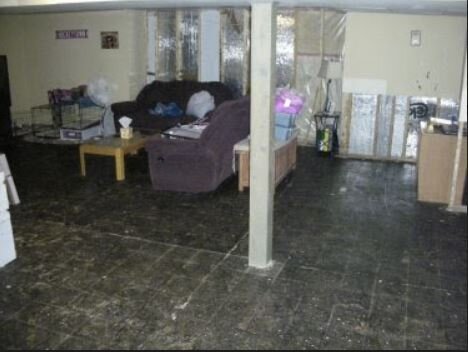Based on over 20 years of experience, we would say that the most popular application for acid staining is a basement concrete floor, as part of a finished basement project in a home. By the time a family gets around to staining their basement concrete floor, though, chances are that it has already been coated with paint, or covered with some kind of adhesive for tile or carpet. That means that in order to stain the concrete, the paint or adhesive has to come up.
Here is a combination of yellow carpet glue, and brown spray paint we encountered on a project. Many paint strippers work on both contaminants. We were able to get all of this off down to bare concrete with Smart Strip Pro so that we could acid stain the floor.
There are two ways of getting paint or adhesive off of a concrete floor: grinding and chemical stripping. Grinding is so dangerous, though, for a non-professional, and requires so much expensive equipment, and experience and skill, that chemical stripping is really the only practical means for a family that doesn’t want to hire out their basement staining project to a contractor. Chemical stripping can be affordable, and doesn’t require a lot of tools or equipment.
At Premier Veneers, we have taken both approaches to removing paint and adhesive before staining projects. The advantage to grinding is that it’s quicker and less messy. The disadvantage is it removes the top layer of cement along with the paint and adhesive, something you never want to do before acid staining, unless it’s absolutely necessary. So all things being equal, we would prefer to chemically strip a floor before staining, rather than grinding.
But chemical stripping takes skill, too, and requires a lot of stripping material to do the job correctly. This article goes into some of the nuances of chemical stripping that, not taken into consideration, and adhered to, can ruin the stripping project, and permanently damage a concrete floor. Stripping a big concrete floor is not like stripping furniture. Stripping a piece of furniture is manageable, and easy to control. Stripping a big concrete floor is not. It needs to be approached carefully at every point of the way.
This basement floor is covered with black mastic, or “cutback” tile adhesive. We used a chemical stripper to get it off, but we had to install a thin cement overlay before acid staining because of all the yellow staining left behind.
We have used a great variety of chemical strippers over the years. One stripper we will not discuss in this article is the kind intended for stripping black cutback tile adhesive. The reason we won’t go into that material is that even after successfully using it on a floor, there is still so much tile adhesive in the pores and micro-cracks of the concrete that it will show up during the concrete staining process. Therefore, using black cutback tile adhesive remover almost always requires the installation of a thin cement overlay before staining.
The type of chemical strippers we will talk about are those intended to remove paint, other colored or clear coatings, and yellow carpet glue. Most of the time this chemical stripper is made of a water-based, eco-friendly material that has the consistency of pudding. The one we use the most is called Smart Strip Pro from Dumond Chemical. Dumond advertises itself as a leading manufacturer of user friendly surface preparations, and cleaning products for the elimination of paint, lead, coatings, graffiti, grease, stains, germs, dirt, and grime.
Smart Strip Pro from Dumond Chemical is not inexpensive. It costs about $60 per gallon, or $300 for a five-gallon pail, so it’s important to use the product efficiently on a large concrete floor.
Smart Strip PRO is an industrial paint remover that removes up to 20 layers of architectural, industrial, and high-performance coatings in a single application. It is non-carcinogenic, non-flammable, non-caustic, fully biodegradable and removes oil, water, latex, acrylic, epoxy, urethane, and elastomeric paints and coatings on interior and exterior wood, brick, stone, metal, concrete, plaster, tile, and decking. This sounds great, and it is, as long as you follow the instructions, and adhere to the nuances.
The instructions for Smart Strip Pro, and other water-based, eco-friendly paint strippers are self-explanatory. They are online, and come with the product, so we won’t go into them. We will cover the nuances, though, and there are basically only three. If you stay aware of these three major nuances, while following the instructions, your stripping project is likely to be a success, and the concrete will be able to be acid-stained without any problems.
First, the instructions for Smart Strip Pro generally say to apply the material at least ⅛” thick. The reason this is a nuance as well as an instruction is that it’s hard to do: when you apply the material with a paint brush, it wants to separate, and cover the surface much more thinly, if you aren’t careful, or conscientious. If that happens, you are not going to get all the paint, coating, or adhesive off in one application, or in a consistent manner. You’ll need to apply more, and other problems can arise.
This four-inch paint brush is called the “Bravo Stainer” from Wooster. It’s perfect for applying chemical stripper to remove paint or adhesive before an acid-stained concrete flooring project.
Generally, that means using one, slow, methodical brush stroke to apply the material, and then leaving it alone. We cannot emphasize how important this really is - you wouldn’t be aware of overlooking, or not adhering to, this step until and unless you did it wrongly.
Second, you have to cover the material with plastic (or “laminate” from Dumond), once it’s applied, so that it does not dry out, and has plenty of time to work. This generally means letting it sit undisturbed overnight. While 12 hours is probably enough, we usually allow for 24 hours. If you allow 24 hours, you will find, almost every time, that the stripper saturates the entire material to be removed, all the way down to the concrete, and wrinkles it sufficiently to be scraped up easily.
If you don’t cover Smart Strip Pro with plastic, it will dry out in about an hour or so, and remain ineffective until you apply more material. If you don’t let it sit 24 hours, you will find that it has only removed - or “detached” - the top layer or so of the coating. Also, Smart Strip Pro is white in color, and if it dries will leave the surface white, and be difficult to remove unless you apply more material with a second application.
We did several samples of different chemical strippers on this stamped concrete patio in order to determine which one would be most effective. We covered the samples with plastic and let them sit overnight.
Third, and finally, before you start the project, you have to do a test sample, in order to make sure that Smart Strip Pro is going to do the job.
Dumond recommends doing an area of about 6” by 6”, and that is about right. What they don’t say is that you need to do this sample in an inconspicuous area, because the edges of the sample area will never blend in with the rest of the concrete when you strip it during the project. It’s not certain why, but there will be shadowing left by the sample area, and it will show through the acid stain later on, and stand out like a sore thumb.
So do the sample in a closet, utility room, stairwell, or if that’s not possible, in an area that is bordered by control joints, or saw-cuts so that the joint or saw-cut prevents a shadowed border. And try your best never to do partial applications of material during subsequent applications to get hard to remove paint or adhesive.
Smart Strip Pro is easy to scrape up, and the concrete is left easy to scrub with detergent and a rotary floor machine in order to get all the residue up. We find we are happy with its performance on almost every single job, as long as we keep aware of the major three nuances. Acid staining is never a problem as long as the instructions are followed, and the nuances not ignored. But if you should happen to forget one of these nuances, you can count on a problem arising, and plenty of stress when you realize it’s not easy to overcome or resolve.





